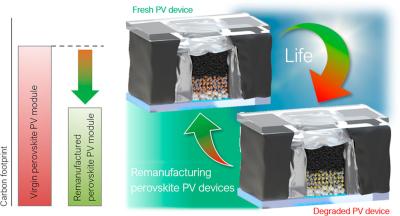An international group o researchers, including ones from the Fraunhofer Institute for Solar Energy Systems ISE, Solaronix, University of Cambridge, École Polytechnique Fédérale de Lausanne (EPFL) and others, have developed a method to re-manufacture fully encapsulated perovskite solar cells after recycling. According to the researchers, the re-manufactured devices can achieve 88% of their original efficiency.
The novel method for re-manufacturing perovskite solar cells (PSCs) uses carbon-based electrodes (CPSMs). Re- manufacturing, as opposed to merely recycling, is described as the combination of re-used, recycled, repaired, or replaced parts to make a new product. “In this work, we demonstrate for the first time a re-manufacturing strategy for glass-glass encapsulated perovskite solar cells,” the scientists stated. “Our study presents a facile experimental method to remove the edge-sealant, encapsulant, back electrode, and degraded perovskite, allowing reuse of the device constituents.”
They initially examined which materials in a module are associated with high environmental impacts. The module they analyzed – which they say has high potential for commercialization – includes a fluorine-doped tin oxide (FTO) front electrode, compact and mesoporous titanium dioxide (c-TiO2 and m-TiO2, respectively), zirconium dioxide (ZrO2), and a carbon-based back electrode. The device is encapsulated with thermoplastic olefins (TPO), polyisobutylene (PIB)-based edge seal, and a glass backsheet.
The team said that only a small part of the global warming potential (GWP) contribution of the cell stack comes from the materials itself (5%), while the majority originates from the energy and solvents used to deposit these layers. The main GWP reduction can be achieved by re-using or recycling the glass (front and back), which can potentially reduce the GWP of PSMs by up to 53% and 52%, respectively. The photovoltaic cell constituents (and their embedded energy) have a relatively small contribution to the overall carbon footprint.
The scientists also determined which components were worth targeting. First, they heated the cell to 120 C to 140 C, to facilitate the mechanical separation of the backsheet glass from the FTO. Then, they left the glass substrates to cool down to room temperature before the encapsulant removal step.
To dissolve the TPO and PIB encapsulant, they placed them in acetone for one hour and peeled them off. Afterward, they dipped the devices into a bath of methylamine (MA0) and ethanol to liquefy and wash out the perovskite – the part most likely to deteriorate in the shortest time.
According to the team, the removal of perovskite and carbon allows reuse of the metal oxide layers (TiO2, ZrO2) deposited on the FTO in order to re-manufacture encapsulated CPSCs. The layer morphology and thickness are preserved. Therefore, carbon deposition and perovskite solution infiltration, followed by the encapsulation with TPO and PIB can be performed again to complete the re-manufacturing loop.
While the recycled solar cell had a power conversion efficiency of 11.7% after the re-manufacturing process, 88% of the original efficiency was kept. Given the efficiency and the resources needed for the process, that led to a reduction of 24% GWP. If the process is further optimized, and the PCE remains the same after re-manufacturing, the drop in GWP can reach 33%.
“Note that, despite fully re-using parts constituting 62.4% of the GWP, the reduction in GWP (compared to virgin modules) due to re-manufacturing is substantially lower,” the researchers said. “This is because of the additional processes required for re-manufacturing. Predominantly the chemical treatment in MA0/EtOH and acetone baths, but also the temperature-assisted mechanical separation of glass substrates and annealing at 400 C result in non-negligible CO2-eq emissions.”
The researchers also determined that the CO2 footprint of electricity generated by the re-manufactured systems could be lower than that of c-Si. In the conditions of Freiburg, Germany, and an annual generation of 1429.2 kWh/m2, the re-manufactured system needed 10.7 years to have lower CO2 emissions per kilowatt-hour than c-Si modules. That compares with more than 16 years with the used virgin modules. If perovskite PV's efficiency reaches the efficiency of c-Si modules, the re-manufactured footprint will be lower after five years.
“Re-manufacturing strategy utilizes solvents and treatments that do not decompose inorganic device constituents, such as metal oxide layers,” the academic group said. “Thus, this approach can also be applied to a broad range of n-i-p devices and some inorganic p-i-n based ones, for which we expect similar reductions in GWP.”


